Thursday, July 7
This morning at Castle Lodge we caught up on correspondence and blog-writing and arrived at the property after lunch. It was a kindness to give ourselves Wednesday evening to rest, and practice. It is good to remember that taking time and space to practice is what makes all that we are doing truly sustainable.
Out at the Living Compassion property there is always something going on. That’s not to say there is a hurried pace. On the contrary, it feels peaceful and relaxed despite the movement and activity. Compared to what busy-ness can feel like in U.S. culture, busy- ness here feels (we project) void of anxiety about accomplishing things. For example, we are a little amazed by the quantity of garments the sewing team is putting out, but as they work they are chatting or silent or even occasionally singing.
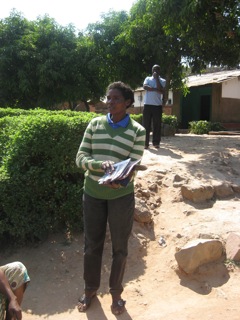
Even though we spent the morning at Castle Lodge, Muyundu was on the property doing his fine job of reporting. Here Ethel is preparing to teach her early morning class.
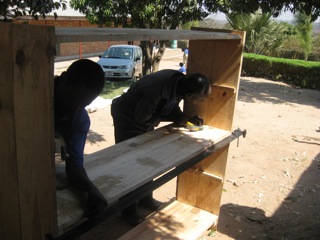
The men are now building their second set of shelves. This one will go in Sister Rose’s building to hold her medicines and other supplies.
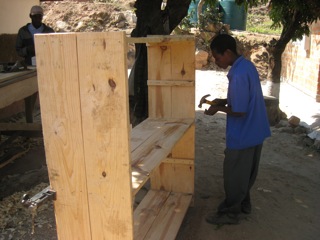
Christopher uses nails that he has dulled the tips of to avoid splitting the wood.

Beatrice, with baby in tow, checks in some of the children for their early meal.
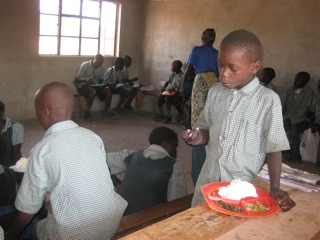
Every day the cooks feed 650 children. Let’s just stop and take that in. One of the things we are looking at with the team on this trip is when and how many children to add next. Amazing!

We made and laminated spiffy new signs for the classrooms and the sewing room.

Here Foster is tailoring one of the long skirts. Doesn’t the freshly painted table look nice? The fresh paint, the new signs, the shelving, all of it adds a feel of care and attention. It feels like it sends a message to all of us that what we are doing is important and worthy of a nice, clean workspace. It almost feels that with things orderly and well- cared-for, there is less place for self-hate to hide. It says, this is a place for the heart.

Another familiar sight - Georgina at her sewing machine. This morning little Gloria gets to come along. The photo makes it look like she must be terribly uncomfortable but she is happily sound asleep.
We arrived at the property a few minutes early for the weekly leadership team meeting. Jen was elected the chairperson at the meeting, and the team, who appreciate protocol, waited for her to call the meeting to order. Veronica read the report (or minutes) from last week’s meeting while everyone followed along.

Jen is calling the meeting to order at the request of the team. See the fist pounding on the table? This elicits a chuckle from all.
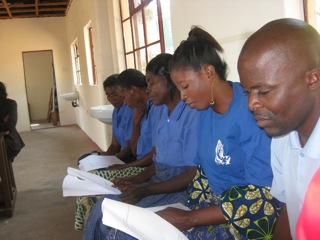
The members of the team read the minutes from last week’s meeting.
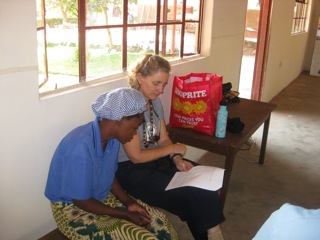
Josephine and Rebecca share a copy of the minutes.
We wish we had the words to describe to you where the meeting went from there. It was a landmark in the project to be sure. We will do our best.
We had decided that in this meeting we would present the stove and sewing agreements we had sketched out with Theresa. At the process level, this trip we are working on making, understanding and keeping agreements. So, we started by recapping this focus and discussing why it is so important, how the ability to be able to communicate well and keep agreements are cornerstones to success on an individual level as well as for the project as a whole.
At the content level, we then walked through how we are going to use the sewing cooperative and the fledgling pulumusa stove business to practice with agreements. For both projects we laid out several goals to achieve between now and Sept. 15. To do this we used what we call at home the “numbers game.” We use this game, for example, if we are trying to decide how many t-shirts we should pre-order for an event. Everyone thinks of a number, and then we all share what number we came up with. Everyone’s numbers almost always come out very close.
We weren’t sure if this would translate culturally but it worked beautifully! For example, we asked the team how much profit from selling sewing cooperative items in the Ndola market seemed reasonable to shoot for in the next two months. Everyone but Martha (the accountant) came out right in the same range. Her number was nearly 3 times the rest of us, and that got a great chuckle from everyone. And so it went with each of the other items: how many stoves we would make, how many stoves we would sell in the local market, etc.
Next we presented the idea we had created with Theresa around accountability. We all wanted a way for the entire team to feel invested in these goals, for everyone to feel responsibility for taking this important, concrete step towards economic sustainability for the cooperative. Theresa felt strongly that there must be some money involved in order to make it real for people. We came up with tying a portion of everyone’s salary to the successful completion of the goals.
We were not at all sure how this would go over with the team, but much to our surprise (and we think Theresa’s as well) there was zero resistance. In fact, there was quite a bit of laughter and a sense that people started to have that “we are in this together” feeling that we were shooting for. So, on October 1, if the targets we decided on together are not met, a portion of everyone’s salary will be held back. It is not a large amount but enough to motivate. We all feel sure it will not come to that, as the goals we created are quite doable and everyone is committed!
That was fun, but the thing that was SO moving was to watch, before our very eyes, how this communication and keeping agreements project is going to be a giant step towards self-sustainability for the project. For example, as we were asking how much profit we should shoot for with the sewing, Ethel asked, "But how can we know that? We don't know what customers will come?" And as we started to explain, Martha (the accountant), jumped in and described how she must meet targets every month at work, and how valuable it is to have targets. And everyone really got it! You could watch it register on people’s faces as they began to understand that we are moving from a “we just get whatever business comes our way” orientation to a “let’s come up with what we want to achieve and go for it” orientation.
Another example: When people really got it that everyone is going to be responsible for making these goals happen, Charles asked, "But what if Lingson (the member of the team who leads the stove production) is sick for a week? How will we still get the stoves done?" And we joked, though quite seriously, “You better make sure he sleeps under a bed net.” And then we talked about the importance of everyone learning the skills we are using, that we cannot rely on just one person holding and understanding the big picture. It was all quite light-hearted and jovial and everyone participated in the conversation-- people asked questions, offered ideas, reflected their understanding of the agreements. It was a delight.
We knew this would be significant, but we had not seen before the meeting how this one little experiment is going to bring in every area we are working on. Suddenly it is going to be in everyone's best interest to stay healthy, to make sure more than one person knows how to do something, to be able to go out and create business for the cooperative, to keep materials costs low. (The cooperative fund is paying for both stove and sewing materials and will pay themselves back with the profits.)
After the meeting the cooperative members had lunch (we had already eaten). As their lunch was ending, we joined them and said to Theresa that we felt like it was a very good meeting. She agreed emphatically and said they had been talking over lunch and that everyone seemed excited, saying things like, "I have a cousin who will buy a stove." We’re all pretty excited!
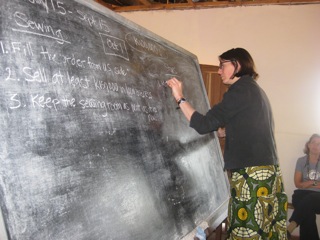
Jen explains the plan for making and keeping agreements. (Note she is sporting one of the new skirtalombas.)
And then, in one of those moments that can make a person religious, just minutes after the meeting adjourned, Friday drove up with drums we had contracted with him to purchase for producing stoves. It was as if Life was just giving us a little “You go, Team!” message. It was fun, too, that we had nothing to do with paying for the drums or for paying Friday to deliver them—it was up to the cooperative to negotiate a good price, since it was their funds being used. This is excellent, not just for sustainability reasons but because they are much better negotiators than we are!
After lunch, the men took the drums and got to work right away on the next stoves.
Friday also delivered some chairs that will go in both Rose’s office and the library the cooperative is planning to build in the next month or so.
Around 4:00, it was time to start the final painting project of the week - the lower half of the walls in the Main Room. It is shocking how much work this group of people can do in a short amount of time. The only other group we know that can rival such productivity is a group of dedicated practitioners on a work retreat. The room was painted and cleaned up in 45 minutes!
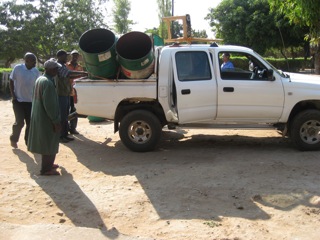
Friday’s white Toyota pick-up truck is always a welcome site.
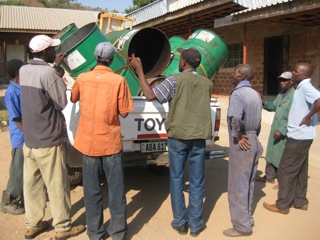
The men unload the drums for the stoves. Each drum will make about 2 1/2 Pulumusa stoves.

These lovely chairs are as comfortable as they are beautiful!
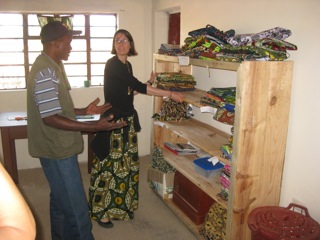
Friday was very impressed with the new shelves and the quality the men showed with the finishing trim work.

While the leadership team was meeting, the rest of the women were busy cleaning the lunch dishes. Feeding 650 children also means cleaning 650 plates every day!
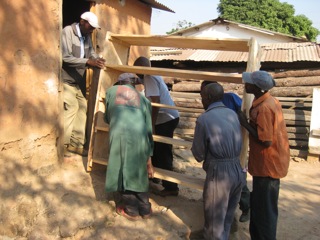
The new shelves are finished will travel to their new home - Rose’s office!
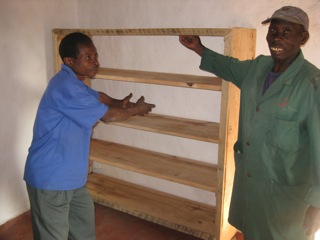
Christopher and Lingson proudly display their handiwork.
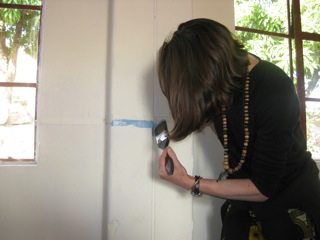
Jen demonstrates how to carefully paint up to but not over the masking tape.
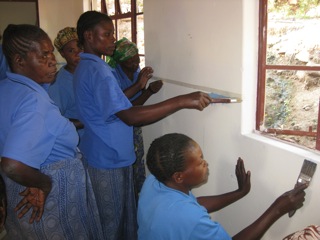
Pauline and Bennendetta painting.
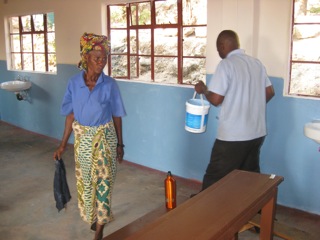
In no time at all, the room is a beautiful blue!
